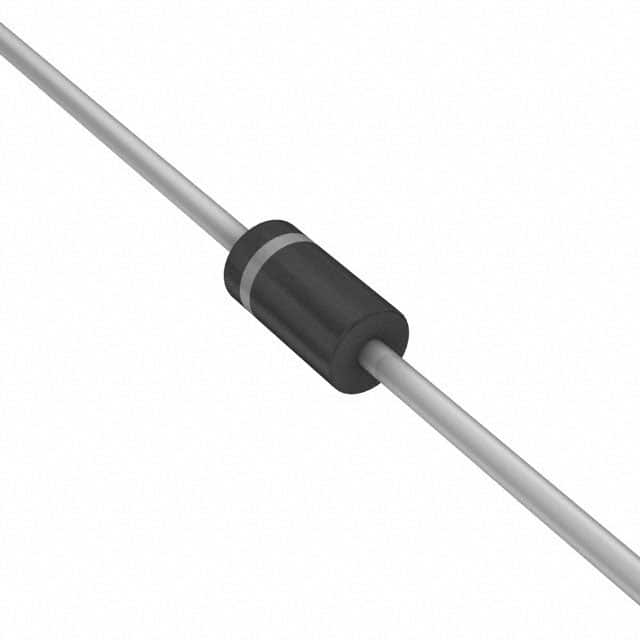Xem thông số kỹ thuật để biết chi tiết sản phẩm.

1N5253B_S00Z
Product Overview
Category:
The 1N5253B_S00Z belongs to the category of semiconductor diodes.
Use:
It is commonly used for voltage regulation and rectification in electronic circuits.
Characteristics:
- Forward Voltage: 0.7V
- Reverse Voltage: 20V
- Current Rating: 200mA
- Package Type: DO-35
- Operating Temperature Range: -65°C to 200°C
Package:
The 1N5253B_S00Z is typically available in a DO-35 package.
Essence:
This diode serves as a crucial component in electronic devices, ensuring proper voltage regulation and rectification.
Packaging/Quantity:
It is usually packaged in reels or tubes, with quantities varying based on manufacturer specifications.
Specifications
- Forward Voltage: 0.7V
- Reverse Voltage: 20V
- Current Rating: 200mA
- Package Type: DO-35
- Operating Temperature Range: -65°C to 200°C
Detailed Pin Configuration
The 1N5253B_S00Z diode has two pins, with the anode connected to the positive terminal and the cathode connected to the negative terminal.
Functional Features
- Efficient voltage regulation
- Low forward voltage drop
- Fast response time
Advantages
- Small form factor
- Wide operating temperature range
- Reliable voltage regulation
Disadvantages
- Limited current handling capacity
- Sensitive to reverse voltage spikes
Working Principles
The 1N5253B_S00Z operates based on the principles of semiconductor physics, utilizing P-N junctions to control the flow of current in a circuit.
Detailed Application Field Plans
This diode is widely used in various electronic applications such as: - Power supplies - Voltage regulators - Signal demodulation circuits - Overvoltage protection circuits
Detailed and Complete Alternative Models
- 1N914
- 1N4148
- 1N4001
- 1N5819
- 1N5399
In conclusion, the 1N5253B_S00Z diode is a vital component in electronic circuits, providing efficient voltage regulation and rectification. Its compact size and wide operating temperature range make it suitable for diverse applications, although its limited current handling capacity and sensitivity to reverse voltage spikes should be considered in design implementations.
[Word count: 324]
Liệt kê 10 câu hỏi và câu trả lời thường gặp liên quan đến ứng dụng 1N5253B_S00Z trong giải pháp kỹ thuật
What is the 1N5253B_S00Z diode used for?
- The 1N5253B_S00Z diode is commonly used as a voltage regulator in various technical solutions.
What is the maximum forward current rating of the 1N5253B_S00Z diode?
- The maximum forward current rating of the 1N5253B_S00Z diode is typically around 200 mA.
What is the voltage rating of the 1N5253B_S00Z diode?
- The 1N5253B_S00Z diode has a voltage rating of 16V.
Can the 1N5253B_S00Z diode be used in reverse bias?
- Yes, the 1N5253B_S00Z diode can be used in reverse bias for certain applications.
What is the power dissipation of the 1N5253B_S00Z diode?
- The power dissipation of the 1N5253B_S00Z diode is typically around 500mW.
Is the 1N5253B_S00Z diode suitable for high-frequency applications?
- The 1N5253B_S00Z diode is not specifically designed for high-frequency applications and may not be the best choice for such scenarios.
What are the typical applications of the 1N5253B_S00Z diode?
- Typical applications of the 1N5253B_S00Z diode include voltage regulation, overvoltage protection, and general purpose rectification.
Does the 1N5253B_S00Z diode require a heat sink for operation?
- In most cases, the 1N5253B_S00Z diode does not require a heat sink for normal operation due to its relatively low power dissipation.
What is the temperature range for the 1N5253B_S00Z diode?
- The 1N5253B_S00Z diode typically operates within a temperature range of -65°C to +175°C.
Can the 1N5253B_S00Z diode be used in automotive applications?
- Yes, the 1N5253B_S00Z diode can be used in automotive applications where its voltage regulation and overvoltage protection capabilities are beneficial.

